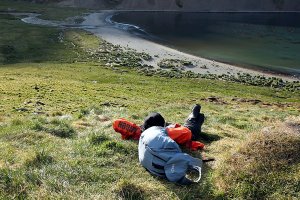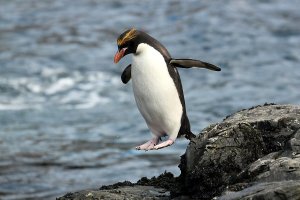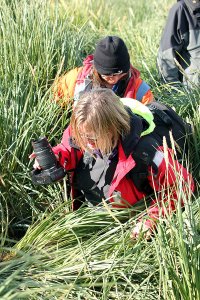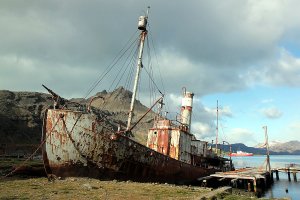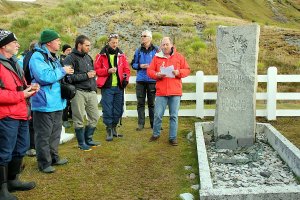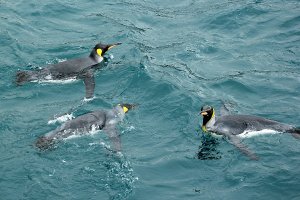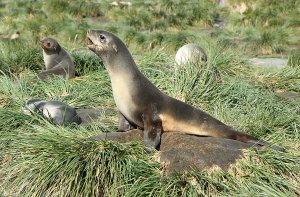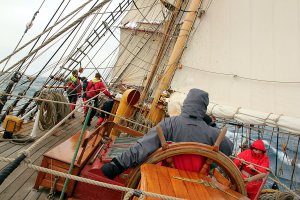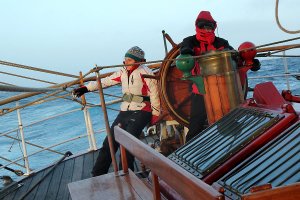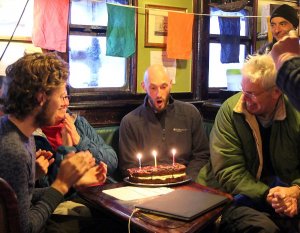Arto's Blog
Stop, sit down and look around
Posted: 2015-09-30 23:22:00, Categories: Travel, Antarctica, Sailing, South Georgia, 707 words (permalink)With limited number of days in an exciting region, it's easy to end
up in a continuous rush of walking, changing lenses, taking more
photos and trying not to miss anything worth seeing. Wisely, our
guide Eduardo reminded us also to stop, put the camera down, look
around and appreciate being in such a unique place.
An excellent chance to do that was at Ocean's Harbor, a sheltered
bay with an old ship wreck slowly rusting near the shore. There were
animals around but no large busy colonies of penguins or seals. We
didn't have any walk led by the guides, just the usual transfer to
the shore by zodiacs and a time to be picked up at the same spot. As
expected, people spread in different directions in small groups or
alone.
It was a warm, sunny day, almost no wind. We walked first along the
beach and then climbed a little bit up the hillside. There we sat
down on the grass and observed the bay from above. Next to us was a
small creek with tiny pools where the water stopped on its way down
to the sea. A solitary fur seal was swimming in one of the pools,
rolling around and clearly enjoying the bath. Cormorants were nesting
in the ship wreck which already had grass growing on the deck. In
the background, the sun was setting behind the mountains, whose
shadow covered more and more of the bay as the evening approached.
On the way back to the pick up point, we saw a couple of South Georgia
pintails, the only duck species living on the island.
Another new species for us were the macaroni penguins, which we
could see during two landings. The funniest place to observe them
was at a rocky shore near Cobbler's Cove, where they were coming out
from the sea and climbing towards their colony. Wingless as penguins
are, they couldn't simply fly over the cliffs like other birds.
Jumping from rock to rock and zigzagging to find a passable route,
they made their way across the tricky terrain.
Our last big penguin colony was at St. Andrew's Bay, a postcard
view of high snow-capped mountains, glaciers and a river flowing to
the sea between green grass fields and tens of thousands of king
penguins. Nearby at Gold Harbour the same afternoon we were still
surrounded by lots of action and sounds, including a large and
smelly bunch of elephant seals spreading sand over each other and
plenty of snowy sheathbills, one of the smaller bird species,
bathing in the freshwater pools. Then we headed to the
south-east corner of the island, where we anchored in a small bay
inside the Drygalski fjord.
Around midnight we woke up to a loud bang. During the night, a
strong katabatic wind had developed and just blown us off the anchor
against underwater rocks. The ship wasn't damaged, but some tricky
maneuvering was needed. The captain turned on the engines and
navigated us out of the fjord in the darkness, between icebergs.
Still in the morning, a strong wind was blowing and prevented us of
doing the planned cruise inside the fjord. Instead, we went to see
our last macaroni penguins in Cooper Bay, wading between some of the
tallest patches of tussock grass we had seen.
Day by day on both Antarctica and South Georgia we got more used to
all the animals around us, but never became bored to observe them.
It was simply wonderful to be able to see all of them so close in
their natural environment, unlike in any other place we had earlier
been to. Penguins remained our favourites, they were simply so cute
and funny that it was hard to resist not to give one of them a hug.
When the days were up and we started sailing east on March 25th, it
was a slightly melancholic moment to say good bye to this very special
corner of our planet.
Whalers and explorers
Posted: 2015-09-17 22:58:00, Categories: Travel, Antarctica, Sailing, South Georgia, 752 words (permalink)South Georgia has not always been the kind of nature sanctuary we were
visiting. It used to be seal hunting grounds at the end of the 18th
and during the 19th century, and a hub of the whaling industry until
1960s. Especially from the whaling period there are many old
buildings and other constructions. They are nowadays slowly
disintegrating due to lack of maintenance, but will most likely
remain for hundreds of years. Now under protection, seal populations
have recovered well from near extinction. Whales have a much longer
breeding cycle and are still a rare sight in South Georgian waters.
Due to the facilities which were manned all year round, South
Georgia was also an important starting point for Antarctic
exploration. Explorers would come in with their ships and get
supplies for the last time before sailing south towards the
unknown. The most famous of them was Sir Ernest Shackleton, whose
heritage is kept alive on the island by the South Georgia Heritage
Trust. The Trust also maintains a whaling museum and runs various
projects in order to preserve the historical sites and to protect
the wildlife on the island.
We started our Museum visit by landing next to the graveyard in
Grytviken bay, where Shackleton and his fellow explorer Frank Wild
are buried amongst the whalers who lived and worked on the site.
According to traditions, the ship barkeeper Andy held a short speech
and we all raised a toast of whisky at Shackleton's grave. Then we
continued towards the whaling station remains and the museum
building, guided by Sarah, the museum director.
Due to removal of asbestos and other security concerns, most of the
whaling station buildings have been dismantled, leaving the huge
kettles, engines and other parts of the processing lines exposed to
the elements of the nature. Although nowadays standing still, the
slowly rusting pieces of heavy machinery and the old whaling ship
wrecks at the shore are a powerful reminder of a bloody chapter in
the history of the island.
Inside the museum the atmosphere was warmer, presenting the more
human side of the story. There we could see how the whalers lived,
as well as to learn more about explorers connected to South Georgia
and about the nature of the island. One particularly fascinating
exhibit was the replica of James Caird, the lifeboat with which
Shackleton sailed 800 nautical miles over stormy seas to South
Georgia in order to rescue himself and his men almost a hundred
years ago. Having just sailed the same route on a much larger ship
helped to imagine how it had been in a small boat, in rougher
weather and almost without supplies.
After a too short visit in the museum, quickly popping in the
souvenir shop and mailing some post cards at the post office, we
returned to Bark Europa for an evening barbecue. Also the museum
staff, scientists and South Georgia government employees working at
Grytviken were invited, giving us a chance to chat with them and get
to know how they live on the island. As on Antarctica, almost all
are there only for the summer season, only a few remain through the
winter.
Not only South Georgia, but the whole experience of travelling on
the Bark Europa is partly a pilgrimage following the footsteps of
early explorers. Their travels and discoveries are remembered, and
the ship route include visits on sites of historical importance. On
this trip, we visited several sites where the Nordenskjöld
expedition had been during 1902-1904 and walked a part of
Shackleton's famous crossing of South Georgia in 1916. During the
lectures, we also heard about earlier sailing expeditions to find
routes across the oceans and around the world since the middle ages,
about Nansen's polar explorations and about Amundsen's and Scott's
race to the South Pole.
Nowadays satellite imagery, the global positioning system (GPS) and other technologies have completely changed the way we travel and look at the world. Bark Europa is equipped with modern navigation devices too, but we also get a chance to learn how to figure out our position using dead reckoning and the sextant, how to measure the speed of the ship using traditional methods and how to navigate using the stars.
Green and lively South Georgia
Posted: 2015-09-04 13:50:00, Categories: Travel, Hiking, Antarctica, Sailing, South Georgia, 548 words (permalink)On March 19th, after eight nights and seven and a half days of
sailing we arrived in South Georgia. Compared to the world of rocks,
ice and snow in South Shetlands and Antarctica, it seemed like a
green paradise. Far from tropical, it was still a harsh landscape
with rocky mountains, glaciers and no trees, but the lower altitudes
were covered with grass and moss, which gave the island a friendlier
appearance.
Fur seal pups were playing in the water and on the beaches, or
resting on top of patches of tussock grass. Penguins waddled in
between, elephant seals lay in big groups and made burping sounds on
the beaches, albatrosses, petrels and other sea birds flew around,
all busy in their own activities. Overall, wildlife was even more
abundant as it had been in Antarctica, and there were some new
species and more youngsters to see. In Antarctica, the breeding
season had already finished at this time of the year, but in
slightly warmer South Georgia it was still going on.
We had a wonderful welcome by king penguins, who swam to our ship
in large numbers curious to see who were coming for a visit. Shortly
afterwards we had our first landing at Right Whale Bay and were able
to observe them on land too. Unlike smaller penguins, king penguins
live on the island all year around and don't all lay their eggs at
the same time, so we were able to see their offspring in all stages
of development. There were mothers taking care of tiny chicks and
brown fluffy youngsters already walking around on their own, between
thousands of bright white-orange-grey colored adults.
The following day at Salisbury Plain we visited an even larger king
penguin colony and had our first experience of the terrain. Due to
large swell we couldn't land at the main beach but had to search for
a more protected spot around the corner. From there, it was a 2 km
walk to the colony over tussock grass and along the beach. The
grass, which looked like a green mat from the distance, consisted of
big patches with mud in between. Seals were lurking in every
direction, some of them still mothers feeding their pups, which made
it a small challenge to find our way through. Sandra and I didn't
mind, for us the walk to the colony and back was as interesting as
the colony itself.
Our first day in South Georgia was cloudy and partly rainy, but
during the following five days we were lucky and had sunny weather.
The sunshine made the mosses on the ground shine in various shades
of green and the landscapes were magnificent. We did a few hikes
which brought us a couple of kilometers inland and to lookout points
up to about 300 meters of altitude. Almost all the wildlife was
concentrated near the sea, so it was quite a difference between the
busy and noisy shores and the calm, quiet inland. We walked in a
group but had many breaks and it was possible to sometimes stay a
bit behind to enjoy the silence.
Towards South Georgia: Seasickness hits again
Posted: 2015-08-31 22:24:00, Categories: Travel, Antarctica, Sailing, South Georgia, 797 words (permalink)After one week of wonderful landings in Antarctica, we started
sailing towards South Georgia, a subantarctic island about 800
nautical miles north-east from the Antarctic Peninsula. The wind was
against us, and Bark Europa like most old tall ships cannot sail in
a very sharp angle against the wind. Therefore we headed first
north-west and later turned eastwards towards our destination,
catching a more favorable wind.
During the first day we had waves coming from several directions
and the ship moved a lot, both back and forth and from side to
side. It didn't take long before Sandra and I were seasick again. We
were not alone — more than half of the people on board got
sick, including several members of the crew.
Some more experienced sailors recommended not take any pills:
it might be worse in the beginning but be over sooner. We followed their advice,
hoping to get used to the movement in 1-3 days, as most
of the people did. Unfortunately we both didn't, and struggled for
the whole week until South Georgia. It was a challenge not
only physically but psychologically, trying to keep the mood up and
enjoy the otherwise exciting trip.
How is it then to be seasick? I would describe it as similar to
having a stomach flu, but with a couple of differences. Firstly,
seasickness doesn't take the feeling of hunger away. So you might
throw up several times but still feel hungry and willing to eat.
That is actually good, it's healthy to drink and try to eat
something even if the food wouldn't stay inside, but it's a strange
feeling. Secondly, the symptoms are very much dependent on what you
do on the ship. General advice such as "go out, watch the
waves, don't look down and read a book" is easy to give and to
find, but eventually you have to experiment yourself to find out
what you can do and which activities are better to avoid. The
feedback comes quickly, it might be unpleasant but not deadly. ;-)
The program on Bark Europa doesn't let anyone become bored during
the sailing days. Everyone is expected to take part in the watch
system where the day is divided in three watches: 12 to 4, 4 to 8
and 8 to 12. During the Antarctica – South Georgia leg Sandra and I
were in the 4 to 8 watch, which means that our daily working times
were from 4 to 8 am and from 4 to 8 pm. Each four hours included
usually 3 half an hour shifts of being either at the lookout
(watching the sea in front of the ship and reporting any obstacles
or potential dangers) or at the helm (steering the ship to a
direction given by the captain). The rest of the time was being
available to help on the deck — which might mean a lot of rope
pulling on a busy day or night, or an opportunity to take it easy
and socialize at the deckhouse when the wind is steady and there is
less to do. Cleaning and cooking was taken care by the permanent
crew, although we did some potato peeling and other
minor tasks.
In addition to the watches and practical sailing lessons there was
a very interesting educational program, consisting of lectures and
documentaries about sailing, navigation, oceanography, history of
polar exploration, polar ecosystems and wildlife in the polar
regions. Each lecture was normally repeated at least once so that
everybody got a chance to attend outside the hours of their watch.
Our guides Jordi and Eduardo were both knowledgeable and
enthusiastic about their areas of speciality, which made the lectures
a pleasure to follow. There were also a few extra lectures given by
members of the voyage crew (passengers) who had something
interesting to share, and more leisurely activities such as playing
card games or watching a movie. And every day someone had a
birthday it was celebrated together at dinner time.
We participated in the watches, lectures and activities as much as
we could. The wind got more steady and our feeling a bit better
towards the end of the passage, but after seven and a half days on
sea we were happy to see the South Georgian coastline. Like in
Antarctica, as soon as we arrived in the more protected waters, our
seasickness was gone as soon as it had started. A new world of
mountains, rocks, snow, ice and wildlife was waiting for us, but
this time there was also a lot of green to see. We would soon land
and have a chance to walk on the Tussock grass.

Copyright Arto Teräs <ajt@iki.fi>, licensed under the Creative Commons Attribution-Share Alike 3.0 Unported License. (Unless otherwise mentioned in individual photos or other content.)
